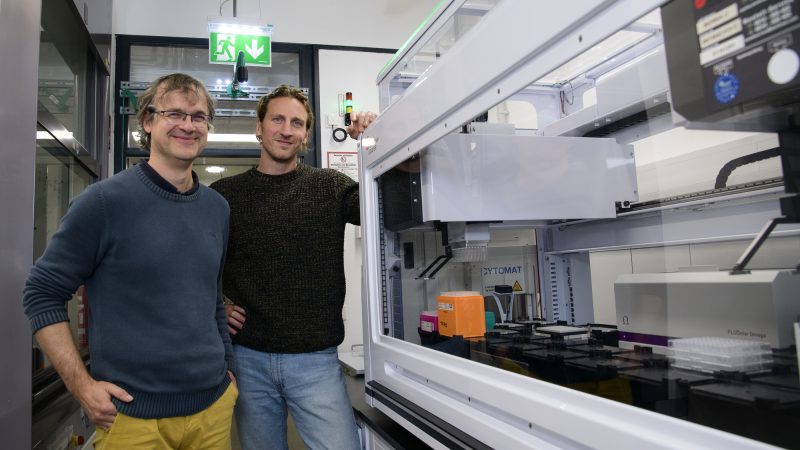Author: Martin Walpot, acib GmbH
Researchers have found a way to make the industrial production of pharmaceuticals, as well as flavorings and biopolymers, more environmentally friendly: Unlike chemical processes that use toxic heavy metals, the new biocatalytic synthesis pathway uses natural enzymes as reaction accelerators. In combination with an innovative enzyme search and screening process, the products can be manufactured faster and much more cost-effectively than before. The process has already been launched on the market: The bisy company is now using the new method to search for new enzymes for customers worldwide.
The medical and pharmaceutical industries still rely on chemicals that are harmful to health and the environment in the production of drugs. These are often heavy metals, which act as catalysts to trigger or accelerate a variety of chemical reactions. Heavy metal compounds are very reactive. Moreover, these reactions take place at high temperatures and in the presence of organic solvents. This produces undesirable by-products that must be disposed of as waste at high cost. Getting from A to B often requires many process steps and detours, making chemical reactions time-consuming and costly. This is one of the reasons why the development of pharmaceuticals takes so long.
Environmentally friendly manufacturing process thanks to biocatalysis
Researchers have now found a biocatalytic route that enables industry to develop drugs more environmentally friendly and faster: It is known from the research literature that there are biocatalysts in nature that enable reactions that established heavy metal catalysis cannot. Therefore, the researchers looked around in nature to see what tools would be suitable for biocatalytic processes. They developed a biocatalytic reaction that uses inexpensive and readily available hydrogen peroxide as the only reagent – familiar from bleaching hair at the hairdresser’s or disinfecting the mouth at the dentist’s. However, a biocatalyst, i.e. an enzyme, first had to be found for this. More than 4,000 enzyme variants were tested in the laboratory for their properties.
In a group of 44 fungal enzymes, biocatalysts were found that are probably used in nature to break down wood components that are difficult to degrade, such as lignin. Until now, it was not known that this enzyme class of non-specific peroxygenases (UPOs) can also carry out biocatalytic hydroxylations that cannot be realized via classical chemical pathways.
Avoidance of side effects of medicines
But before fungal-derived enzymes can be used as reaction accelerators for the industrial development of drugs, they must first be tested for their enantiopreference, i.e., their ability to distinguish between enantiomers. Enantiomers are groups of atoms in a molecule that are spatially arranged like left and right hands to each other, but are otherwise identical in their physical and chemical properties. The difference is important for their reactivity to other three-dimensional, chiral compounds like the biomolecules in our human bodies.
You can think of it like shaking hands: When we extend our right hand in greeting, we expect our counterpart to extend their right hand to us as well. The left hand, on the other hand, would cause irritation. Transferred to drugs, this means that the wrong enantiomer can even be toxic.
Therefore, the first step is to find out the preference of an enzyme. Which enantiomer, which hand, does it produce? Only then can the right active ingredient be produced, and only then can the body and the active ingredient give each other the “right” hand and the active ingredient exert its effect. Another hurdle: Determining enantiopreference quickly and easily is a challenge. Investigation methods such as spectrophotometric high-throughput screening have hardly been carried out in biocatalysis to date.
Finding the needle in the haystack faster
For this reason, a new, innovative search and examination method for enzymes has been developed: The enantioselective high-throughput assay makes it possible to find the needle in the haystack, in this case a biocatalyst for a specific application, and to test this biocatalyst for its properties in just a few days, rather than the weeks it usually takes. The assay provides two types of information: How well does the particular enzyme perform? And what enantiopreference does it possess, i.e. does it form the left hand or the right hand – or both?
The new method has the potential to significantly speed up the development phase of procedures. As a result, drugs could not only reach the market more quickly, but could also be produced much more cost-effectively. The new reaction also has the advantage that the biocatalytic production of drugs leaves a much smaller environmental footprint: Toxic heavy metals as reaction accelerators, harmful solvents as substrates and expensive process infrastructure are eliminated because the processes take place under room pressure, in an aqueous environment and under normal ambient pressure.”
Enzyme kits already on the market for industrial use
The researchers scored another success: In a strategic acib project, the biotechnologists are collaborating with the company bisy, which specializes in the production of enzymes from fungi. Bisy GmbH is currently the only company in the world that can produce these enzymes on a kilogram scale and make them available to customers. This enables companies around the world to test their substrates and reactions and bring new products to market in less time – from pharmaceuticals to flavors to biopolymers.
Publication:
Enantioselective High-Throughput Assay Showcased for the Identification of (R)- as well as (S)-Selective Unspecific Peroxygenases for C−H Oxidation
Alexander Swoboda, Lukas Johannes Pfeifenberger, Zerina Duhović, Moritz Bürgler, Dr. Isabel Oroz-Guinea, Klara Bangert, Florian Weißensteiner, Lena Parigger, Katharina Ebner, Anton Glieder, Wolfgang Kroutil
Angew. Chem.Int. Ed. 2023, e202312721 (8 pages). https://doi.org/10.1002/anie.202312721
Picture credits: University of Graz
